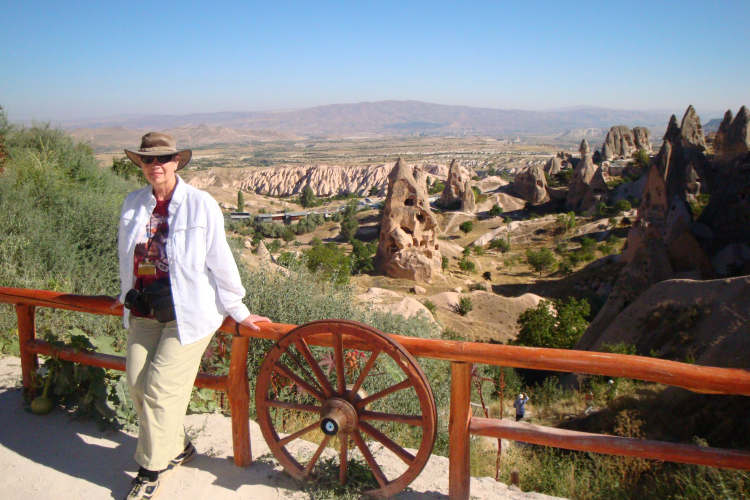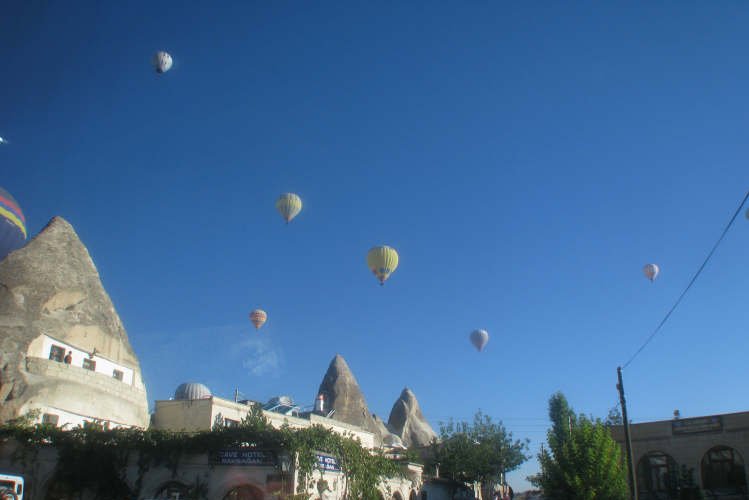Turkey--2010
J.T. and Dioane Smith
We flew into Istanbul via Chicago. Total travel time was about 20 hours. Spent two days touring Istanbul seeing the Spice Bazaar, Grand Bazaar, Blue Mosque, Aya Sofia, Hippodrome, Sultan's Palace, Boat Ride on The Bosporus, plus a couple of museums. Then, we made a 2000-mile bus ride around southwestern and central Turkey.
The first day we traveled along the northern coast of the Sea of Marmara to the Gallipoli peninsula, stopping at the ANZAC Cemetery and WWI Memorial before making the ferry crossing to Canakkale on the Asian side of the Gallipoli Strait. The WWI battle of Gallipoli, a disaster for the Allies, was successfully conducted by Mustafa Kamal, later known as Ataturk. Following WWI, the Greeks were ceded and occupied much of today's Turkey as their 'spoils of war.' It was Ataturk who ultimately drove the Greeks out of Anatolia and founded the independent Republic of Turkey.
The next day we stopped to explore the ruins of Troy while enroute to Izmir. Actually, the ruins include nine separate towns/fortresses built on the same hill over thousands of years. For those who have seen movies about Helen of Troy or recall Homer's tales of this place, it all seems a bit anticlimactic. It was really a rather small place, basically a fort on a hill overlooking a small port. In those days the sea reached the city; now there are 6+ miles of alluvial plane to cross before reaching the sea.
We spent two days in Izmir. The first day we backtracked along the previous day's route to explore the ruins of Pergamum near Bergama. Most of the treasures there have been relocated to a museum in Berlin, but there is still enough there to get a good feel for the place. The Roman vaulting architecture still supporting much of the structure is impressive, having survived a lot of earthquakes over the years. The second day consisted of the typical city tour and some leisure time to explore Izmir.
Our first stop after departing Izmir was to explore the ruins at Ephesus. They are more complete than those we saw in Greece and give a better feel for what life might have been like in those days. We also visited what is purported to have been the site of the home of the Apostle John and the Virgin Mary. What is there to see is a small church built over the ruins. Actually, there were a total of four locations called Ephesus in this area as the city was moved from time to time. The final location was an acropolis in what is now the city of Selchuk, and buried there are the remains of St. John.
After leaving Ephesus, we traveled inland to Pamukkale (near Denizli) for our next stop. In the vicinity of Pamukkale are the remains of the Greek city of Hierapolis and the Travertine bluffs formed by deposits of calcium chloride from a thermal aquifer that surfaces nearby. The many thermal pools in the area have for many centuries made this a popular resort area. Diane had a lovely time in the large warm pool at our hotel.

Next, we moved back to the Mediterranean coast at Antalya. This is a favorite vacation spot for Germans, Russians, and Iranians. While in Antalya we visited the ruins of the Greco-Roman cities Perge and Aspendos. The theater at Aspendos is the most complete example of that classic structure, and the acoustics are indeed remarkable. You can easily hear normal speech from the orchestra at any seat in the 'house.'
Leaving Antalya, we traveled inland through the mountains to the Cappadocia region in central Turkey. Along the way, we stopped for lunch in a small village in the mountains where the principal income comes from harvesting and processing pine nuts. Our hosts were a middle-aged Turkish couple who served us local foods and gave us a tour of their home. Since they spoke no English and all we had was a sheet of 'useful words and phrases,' communication was mostly accomplished by gesture and expression. Lots of laughing kept conversation moving.

After lunch we made a brief stop in Konya to visit the Mevlana museum and then continued on to our hotel in Nevsehir. The main attractions in Cappadocia are the geological formations known as Tufas. The cone-like formations (think of the movie Coneheads) are the result of millennia of erosion. Many have been tunneled into to form homes, shelters, even churches. Some of these 'Cliff Dwellings' are still inhabited. For those so inclined, one of the activities to view this area was a morning hot-air balloon ride, which Diane and I declined--she because it involved an early get up, and I because I still don't do high places very well.
Other activities in Cappadocia included watching a master potter (who's a dead ringer for Albert Einstein) demonstrate his considerable skills by expertly fashioning a lovely teapot. This, of course, was followed by an opportunity to browse his finished wares of which he is apparently extremely proud given the prices. A similar experience then followed at a local carpet facility. I must admit that I was tempted to acquire another example of the excellent Turkish carpets, but Diane convinced me that the one we already had was sufficient. The afternoon was completed by a visit to a Sufi Mosque where we witnessed a traditional Whirling Dervish worship ceremony. Their ability to whirl continuously without seeming to get at all dizzy is truly impressive, especially to me who has trouble getting through even a brief Viennese Waltz without staggering off the floor.
Leaving Nevsehir, we traveled northward to visit the ancient Hittite capitol of Hattusa, perhaps the oldest city yet discovered in Turkey. From there we traveled westward to our final destination, Ankara. On our final day we toured the 'old city' on foot, visited the excellent museum, and enjoyed a farewell dinner before turning in early in anticipation of the '0-Dark-30' getup to catch our flights homeward. We arrived in Atlanta just before midnight nearly 26 hours after leaving Ankara, then drove home to Clarksville, TN.











